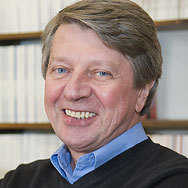Editor's Note:
In the Dialogue with Scientists series, National Business Daily (NBD) examines how the frontiers of discovery are shifting in the wake of the 2025 Nobel Prizes. From molecular design to life’s origins, our conversations with one of the pioneering minds reveal how modern science advances—not by certainty, but by curiosity and doubt.
The rapid rise of large language models is now giving way to the next frontier: embodied intelligence. Unlike traditional AI confined to a digital "brain", this new paradigm emphasizes the crucial role of a physical "body" that can interact with the environment in real time.
This raises a pivotal question: how can we build such a "body" that is both sensitive to its surroundings and capable of precise action? The answer may lie in intelligent materials.
In an exclusive interview with National Business Daily, Polish-American chemist Professor Krzysztof Matyjaszewski of Carnegie Mellon University elaborated on this vision. He defined intelligent materials as the core of intelligent systems that can respond to certain external stimuli such as light, temperature, pressure or vapors of certain chemicals.
Beyond defining the goal, he pointed to a powerful accelerator. "The biggest opportunities for integrating AI in polymer chemistry are to accelerate the research and to provide faster approach to new materials," he noted.
Prof. Matyjaszewski has received numerous awards for his work, including the 2023 National Academy of Sciences Award in Chemical Sciences, 2021 Grand Prix de la Fondation de la Maison de la Chimie and 2011 Wolf Prize in Chemistry.

Krzysztof Matyjaszewski (Photo/Carnegie Mellon University's website)
Intelligent Materials: Crafting the "Body" Future Robots Need
The concept of intelligent materials is central to bridging the digital and physical worlds for robots. A prime example critical for robotics is self-healing materials.
According to Prof. Matyjaszewski, intelligent materials are related to the intelligent systems that can respond to certain external stimuli such as light, temperature, pressure or vapors of certain chemicals. "The self healing is an unusual process which requires sufficiently soft materials but also sufficiently strong materials which would not flow and will not be dominated by creep behavior."
To achieve this delicate balance, his research often focuses on hybrid systems. Prof. Matyjaszewski said, "We sometimes prefer the materials based on the hybrid systems which incorporate hard segments but also some soft segments responsible for self-healing. In that case, they can self-heal, but can also remain hard with the moduli approaching or exceeding 1 gigapascal, like hard plastics, such as plexiglas."
ATRP: The Foundation for Precision Engineering of Polymers
The ability to create such sophisticated materials did not appear overnight. It is built upon a foundational scientific breakthrough: Atom Transfer Radical Polymerization (ATRP), a technique discovered by Prof. Matyjaszewski in 1995.
ATRP is widely regarded as one of the most significant advances in polymer science of the past half-century because it finally allowed chemists to exert unprecedented control over the molecular architecture of plastics.
This was a stark departure from the past. Prof. Matyjaszewski recounted that traditional radical polymerization, despite producing over 100 million metric tons of materials annually, was "notoriously poorly controlled". Before ATRP, he said, "It was not possible to prepare polymers with precisely controlled molecular weight, narrow molecular weight distribution or also with desired functionalities."

Photo generated by AI
ATRP changed everything by marrying the robustness of radical polymerization with the precision of ionic polymerization. Its transition from an academic discovery to a global industrial standard enabled the synthesis of complex, tailor-made polymers—from star and comb shapes to massive "bottle-brushes" with molar masses exceeding 10 million daltons.
The work continues. "One of our targets is to make ATRP more robust, more selective but also using lower amount of catalyst and working on the continuously improved conditions," he said, highlighting efforts to make the process work in the open air or water under homogeneous or heterogeneous conditions.
The main targets are materials with controlled architecture, controlled dimensions, controlled functionalities, controlled shape and controlled composition, and such materials can be employed for different purposes, he added. "Our goal is to design these materials, precisely make them, characterize them, and find some special applications. These applications can be in biomedicine, in the environmental area, or energy, or be used as an unusually soft, hard, or self-repairing system."
Faster, Cheaper, Better: The Promise of AI in Accelerating New Materials Research
While ATRP provides the tools for precision, AI is now emerging as the force that will dramatically accelerate the entire discovery cycle.
Across leading labs, from MIT to Carnegie Mellon University, AI and machine learning are being deployed to screen hundreds of polymer blends daily and design better materials faster.
Prof. Matyjaszewski is optimistic about this synergy. “The biggest opportunities for integrating AI in polymer chemistry are to accelerate the research and to provide faster approach to new materials,” he noted.
He detailed that AI and machine learning are very promising tools to understand how synthesis can be performed better, more efficiently, and more greenly, and also how we could expand the range of monomers, relax reaction conditions, and have more selective materials with a better atom economy or molecular economy.
Looking ahead, he envisions a future where AI will enable the preparation of new polymers "in a less expensive way and target better materials properties". This technological convergence, however, serves a larger purpose. For Prof. Matyjaszewski, the future of chemistry is not just about making new things, but about making them smarter and within a responsible framework.
"My belief is that in the next 10 or 20 years, we will further advance our fundamental understanding of chemistry through a better grasp of computational opportunities, including machine learning and AI," he shared, outlining a holistic vision for the field. "We need to talk to specialists in different areas of material science, biomedicine, or environmental and energy-related fields, and translate their needs so that we can design more powerful molecular structures. We also need to think about sustainability, to recycle or depolymerize polymers back to monomers and also use monomers from renewable resources."


 川公网安备 51019002001991号
川公网安备 51019002001991号





